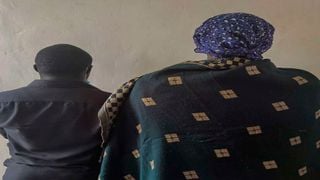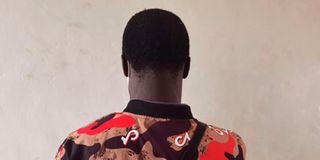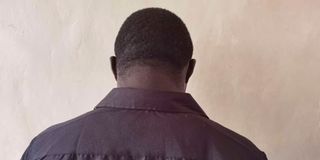
Intersex persons during the interview in Kisii on September 29, 2021.
| Ondari Ogega | Nation Media GroupNews
Premium
It’s a tough life for little-understood intersex people
Few choices would be harder to make than coming round to accept that you are neither male nor female.
Add to this the fact not much is known in the Kenyan society about the intersex people, who have both male or female features.
The dilemma is even more pronounced for parents and caregivers, who are at a loss on whether to give an intersex baby a male or female name.
With time, however, the male or female characteristics start gaining prominence, allowing one to go for a gender identity that suits the body changes.
Nevertheless, it is a tough life for the intersex people in Kenya.
An intersex person is one who was born with sex characteristics – including genitals, gonads and chromosomal patterns – that do not fit typical binary notions of male or female bodies.
Kenya officially has 1,524 recorded intersex persons, with Nairobi having the largest number at 245, followed by Kiambu (135) and Nakuru (95). Kisii County has 38, Mombasa 30 and Wajir 49.

An intersex person during the interview in Kisii on September 29, 2021.
Attraction to women
The Nation caught up with a few of them. We shall call the first person Grace.
Grace is 26 and lives in Nairobi, though his/her rural home is in Vihiga County. She discovered that s/he was intersex in 2019 when her/his male organs started growing bigger and s/he started getting attracted to women.
It is hard to tell whether Grace is male or female from the outward appearance.
Her/his face would be hard to place into either gender, though the voice would lead one to conclude s/he is female. S/he has hips and a small waist.
S/he keeps her chin clean-shaven, to avoid unnecessary attention.
“I have both organs, though the male one is dominant. This initially used to bother me, but I have now accepted who I am because I have no control over nature,” she says.
S/he initially used to menstruate, but this gradually stopped and s/he now gets just drops.
Grace was among intersex persons who visited Kisii County on Tuesday for a stakeholder’s awareness meeting.
The Kenya National Commission on Human Rights (KNCHR) had organised the meeting that brought together officers from the National Police Service, the Ministry of Education, the Prisons Department and the Registrar of Births and Deaths.
Representatives of Intersex Persons Society of Kenya and parents of intersex children shared their challenges and experiences.
Inaccurate figures
The official statistics on intersex persons are most likely inaccurate as some fear revealing their status in an increasingly judgemental society.
Most people still associate being intersex with a curse on their parents and community. In some communities, it is taboo to broach the subject.
“Such widespread ignorance and mistaken beliefs point to the need for a comprehensive and systematic public awareness campaign in partnership with key institutions and stakeholders,” said Western Region KNCHR Coordinator Jacqueline Ingutiah.
Grace has undergone cyber bullying and body shaming by people whom s/he trusted and was abandoned by her/his father immediately her/his mother died in August 2009.
“Immediately my mother’s remains were interred, my father called a family meeting and disowned me,” said Grace.
Grace hopes to get a wife someday and prefers a mature woman.
Intersex persons with dominant male organs, however, suffer immature ejaculation and many of them may not be able to sire children.
Stella (not her/his real name) is an intersex person from Chebilat, on the border of Nyamira and Bomet counties.
S/he is 20 and wants to join the Kenya Medical Training College to study Health Records and Information Technology studies.
But s/he does not know whether to put on a girl’s dress (the blue dress usually worn by nursing students) or trousers.

An intersex person during the interview in Kisii on September 29, 2021.
Grew up as a girl
“My name suggests I am girl yet in all appearance, I am a boy,” said Stella.
Stella grew up as a girl but towards puberty, her/his male organs became dominant.
S/he has no visible breasts and has both male and female genitalia, though s/he feels male. Her/His voice cannot easily be termed as either male or female.
There was a time s/he was attracted to men, but this changed on becoming a teenager.
“Nowadays I am attracted to women. I do not know about marriage and have never thought about having a wife,” s/he said.
S/he says at one point s/he wanted to commit suicide because s/he just could not understand herself/himself.
“I have been raised as a female but when people look at me, they see a male. People discriminate against me because of that,” s/he said.
And Nyakundi, 24, from Marani sub-county in Kisii County, is an orphan. His/her parents died in 2013 when s/he was in Standard Eight.
In 2019, s/he wanted to commit suicide because s/he felt that she was of no value.
“I felt there was no need to continue living. Poverty and my condition drove me to depression, but a neighbor rescued and housed me,” s/he said.
Nyakundi grew up a boy, hence the male name, though s/he now feels female.
S/he has female organs and menstruated only once in her/his life. Her/His voice is distinctly female.
Ms Ingutiah, her deputy Mary Beryl Orao and Head of Public Affairs and Communication Dominic Kabiru led the KNCHR team in the Kisii meeting.
“During the 2019 Housing and Population Census, the government approved the introduction of the third gender, which is as a result of birth and not by choice,” said Mr Kabiru.
KNCHR asked Parliament to work with stakeholders to facilitate recognition of intersex persons in the law.
This, the commission said, could be realised through the introduction of an intersex (I) marker in all official documents that require identification of sex,” said Ms Orao.
The report of the Task Force on Policy, Legal, Institutional and Administrative Reforms Regarding the Intersex Persons in Kenya, 2018 noted that there were low levels of education and low transition rates among intersex persons.
This has been attributed to institutionalised bias against intersex persons, including in the educational system.
Some intersex persons opt for corrective surgery, which most cannot afford.
Parents and caregivers who had their children undergo corrective surgeries reported having mixed feelings on the decision to go for it, the procedures and the outcomes thereof.
A majority of intersex persons expressed dissatisfaction with access to employment opportunities.
Intersex people also complained that they find themselves exposed to intrusive and unnecessary searches in the institutions charged with administration of justice.
The detailed how they are remanded with other male and female inmates, exposing them to sexual harassment and other dangers.
The task force report on their welfare recommends expeditious provision of birth certificates, identification documents, passports and other official personal documentation by including provisions for an intersex (I) marker.
“The legislature to facilitate review of laws to ensure equal treatment, respect and protection of the dignity of intersex persons within the criminal justice sector.
Most admitted they had self-awareness issues regarding their sex status and its causes, with many relating it to a curse or punishment for some sins committed either by them or their parents or forefathers.
The common belief and feeling patterns exhibited by their parents or guardians include: thoughts and regrets, family break-ups or abandonment of the mother by the husband and their relatives; resorting to traditional healers, priests and herbalists, many of who may prescribe ‘purification ‘rituals or downright infanticide.
Others seek help from medical facilities where they run the risk of misdiagnosis and wrong surgical interventions to ‘normalise’ the child.





